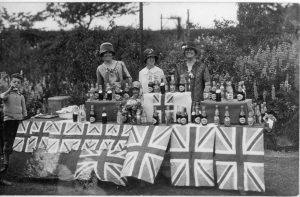EDWINSTOWE IN THE 1920’S
One hundred years ago, when people witnessed the unveiling of the War Memorial at the
Crossroads, little did the residents of Edwinstowe, a quiet agricultural village, realise how
their way of life was to change when a coal mine was sunk on the outskirts of the village.
In 1925 work began to sink Thoresby Colliery. The building of 500 colliery houses started in
1926 and was completed by 1931, attracting many new families. Edwinstowe Hall was
purchased by the Bolsover Colliery Company for use as a Welfare Centre for its employees,
and was visited by the Prince of Wales who congratulated the Company on the Welfare
Scheme (1923).
Spectators would watch Edwinstowe St Michael’s football team, and the village cricketers
whose matches were played in idyllic surroundings on Forest Corner. The Edwinstowe
Allotment and Garden Holders’ Association held their annual shows and the annual fair was
a welcome attraction, so too were the charity Garden Fetes, whist drives and concerts in the
church. St Mary’s Church, the Primitive and Wesleyan Methodist chapels were meeting
grounds as were the Edwinstowe Women’s Institute and the Edwinstowe Mothers’ Union
which were inaugurated in 1920 and 1924, respectively, also the British Legion.
When walking down the High Street one would see Dowse’s Drapery Store; tea room;
shoe shop; Staley Lowe’s garage; bakers; the Co-op; Freeman’s and Newton’s butchers’
shops; Mr Lowe’s barber’s business conducted in a hut which was reached by wooden steps
behind one of the cottages; the Institute which was a men’s meeting place with a billiard
room; Telephone Exchange; Jack Lacey’s, cobbler; Tudsbury’s China Shop; Kisby’s and
Fenton’s sweet Shops; a Motor Mechanic’s Workshop; Parnell’s grocer; Newsagents; the
Methodists’ chapel; the Royal Oak; Jug and Glass; and Black Swan. A little further on there
were the Dukeries Hotel and the Robin Hood Inn. The village Lock-up provided overnight
accommodation for any miscreant who fell foul of the law,
The Fire Service was called into action in 1929 when the Dukeries Hotel caught fire and
suffered extensive damage.
Education was provided by St Mary’s School, and in 1926 a temporary building was erected
for the “new village children”, with the first portion of a permanent Council School in use by
1928.
During the course of 10 years a new sewage and water works had been opened and
Mansfield Road as far as Warsop Windmill was widened to accommodate the increase in
traffic. Although travel by train and carrier to Mansfield was the only method of public
transport, the 1930’s would see the introduction of omnibus services to nearby market
towns. A cinema would be built, the colliery would provide electricity to the village, tennis
courts, putting and bowling greens, and a sports’ ground.

Lowes Garage and Kirkstall Café on right c1920s

British Legion Members. The Old Vicarage, 1929
 Edwinstowe Historical Society
Edwinstowe Historical Society